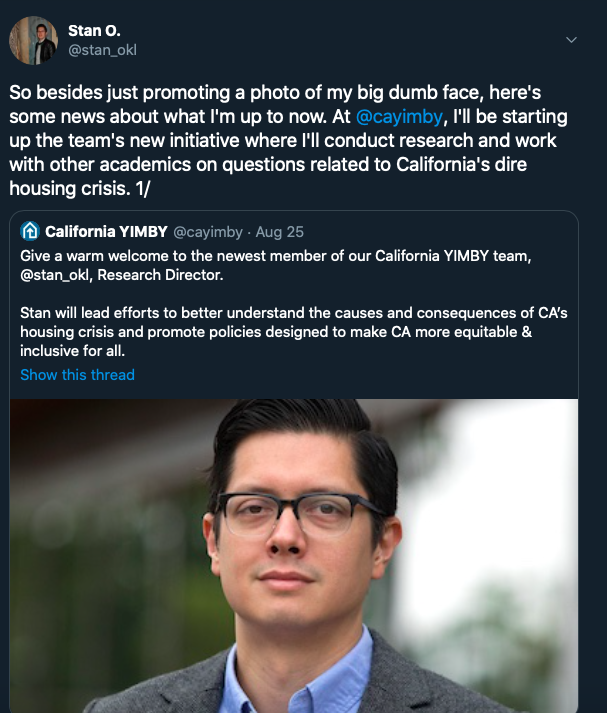The HomeWork: August 27, 2020

Welcome to the August 27, 2020 Main Edition of The HomeWork, the official newsletter of California YIMBY — legislative updates, news clips, housing research and analysis, and the latest writings from the California YIMBY team.
News From Sacramento
California’s 2020 Legislative session wraps up on August 31st, and there’s still plenty of work to be done. We’re hitting the phones and/or closely watching the following bills, which all still need floor votes in their second houses:
- SB 1120: The most significant housing reform of the year, SB 1120 follows research from experts at UCLA, and legalizes affordable duplexes across the state.
- AB 725: This bill will make cities include more multi-family housing in their plans for more “naturally” affordable housing, which is housing that doesn’t require subsidies but is still affordable to middle-income Californians. Many cities have skirted their middle-income housing requirements by forcing all such homes to be single-family — which are more expensive.
- AB 3182: AB 3182 makes it legal for homeowners whose properties are in a homeowner’s association (HOA) to rent their homes out. Approximately 25 percent of all housing in California belongs to an HOA, but under current law, HOA’s can legally ban renters — dramatically reducing the amount of rental housing available.
- AB 1436: With the Judicial Counsel’s moratorium on evictions set to expire on September 1, this bill is the last remaining tenants’ rights bill that could stave off a wave of evictions.
Housing Research and Analysis
How Legalizing Homes Can Integrate the Bay Are
In an early installment of The Homework, we covered the first few research briefs in a new series from UC Berkeley’s Othering and Belonging Institute (OBI) on the Bay Area’s deeply entrenched residential segregation. In this final episode of the series, OBI’s Menendian, Gambhir and Gailes propose key reforms for desegregating our region’s cities
Key takeaways:
- Single-family zoning keeps our region segregated. While cities with more single-family zoning are whiter and less diverse, cities that allow more multi-family housing are more diverse overall, yet may be more internally segregated within city boundaries.
- Rent control policies could be better-targeted to promote integration, but there needs to be more research on this approach.
- Actively integrating segregated areas takes several approaches to produce affordable housing and encourage social and economic mobility.
How does the rest of the world provide housing?
A globetrotting new whitepaper from SPUR looks at policy regimes in other countries that manage demand for housing with measurably more success than California. Three city profiles help give a sense of the bigger picture.
Key takeaways:
- Vienna funds, builds, and maintains a large stock of affordable housing through strong national and local government. Housing isn’t strictly a local matter there, and it’s considered more of a civic obligation than a speculative investment vehicle.
- Tokyo enforces national zoning rules and provides cheap mortgages for plentiful housing that rapidly depreciates rather than building value as an investment
- Singapore owns most of the land in the city-state, and builds lots of dense housing, but actively promotes homeownership
Houser Headlines
- Why Sprawl Could Be The Next Big Climate Change Battle
- Single-family housing in the Bay Area linked to more racially segregated cities
- Trump’s tweets about saving the “Suburban Lifestyle Dream,” explained
- Can you tell which comments about housing are from Trump, Democrats, or upzoning skeptics?
- Decoding Trump’s Racist ‘War on Suburbs’ Rhetoric
- Housing will test white support for Black lives
- Improving Transit Equity in L.A. During the Pandemic
- Coronavirus: No Bay Area exodus
- No deal yet in Sacramento to help struggling California renters
- Pandemic saps state effort to curb housing crisis
YIMBY Social – Top Posts

Share the good word
We welcome your ideas and feedback — send story tips and ideas to Homework@cayimby.org.
Did someone forward this email to you? Sign up to get it here.


